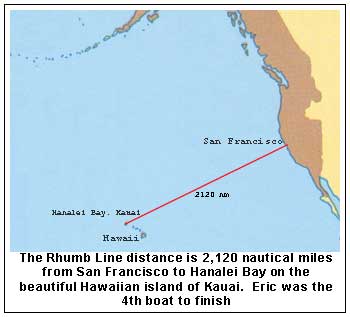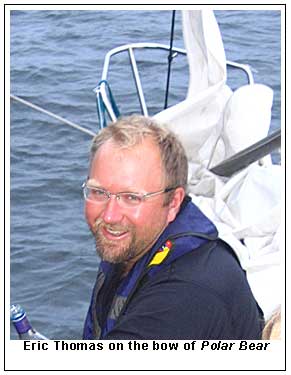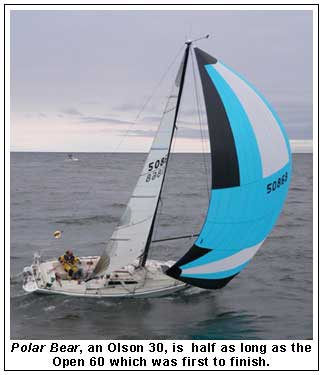|
Duluth Native, Eric Thomas, Wins Class and Second Overall in his First Singlehanded TransPacific Yacht Race
2,120 Miles across the Pacific, San Francisco to Hanalei Bay, Kauai
By Thom Burns
The TransPac started on July 12 from the Corinthian
Yacht Club in San Francisco Bay, and finished at
beautiful Hanalei Bay, Kauai - a tropical paradise
in every sense. This is not your ordinary sailboat
race. This is the Singlehanded TransPac, with 30
years of style and tradition.
 Eric aboard his Olson
30, Polar Bear, finished in 14 days, one hour, 53
minutes and 27 seconds. On day 13, his wife Sarah
flew over to meet him at “The Tree” on the beach at
Hanalei Bay, Kauai. This is one of the time honored
traditions of this grueling race.
All was not easy for
Eric. The race started in light air, rain, fog and
plenty of shipping off San Francisco. After several
days the Pacific High settled in which increased the
wind and brought routine squalls with their
associated winds and rain followed by light air.
This combination caused troubles big and small with
one boat returning to San Francisco, another
dismasted but still proceeding to Hawaii under a
jury rig at press time, and several hair raising
experiences.
On his online log
Eric describes the sailing side of the game seven
days into the race, “I just got run down by a
squall, I was dozing in the cockpit and could feel
the boat accelerate. We had 25-31 knots of wind for
about an hour. It was pretty nerve wracking. I
managed to keep the boat under the kite the whole
time, got to 17.1 knots three times. The swells are
moving about 13-14 knots is my best guess so we
spent most of the time going that fast. Now the sun
has come out for a bit, I think the squalls kind of
suck up the clouds locally and give a bit of sun
before and after. The wind is now in the teens and
we are doing 8 knots. It seems so serene.”
The equipment side of
the race is frustrating and necessitates constant
vigilance. The autopilot is battery driven and the
power comes from solar panels recharging the
batteries. Around day seven, Eric reported making 10
amps of solar power, “now that the sun has come
out.” From his log, “I have the (auto) pilot set
pretty high as there is sun to burn and it is back
there sawing back and forth. It actually has two
speeds so it kicks into high gear back and forth
back and forth. It drives a lot better than me
because I tend to fall asleep at the helm and crash
jibe the boat.”
 As part of the daily
routine for safety, “I am clipped on whenever I am
out of the cabin. My big worry has been the rig and
the fact that losing it would make this a really
long downwind race. Luckily the wind blows towards
Hawaii and one would eventually get there. Enough
rambling, it is time to tighten the tiller head
fitting on the rudder post, it’s starting to work
loose. I’ve got to get done before dark and do a
general scout around the deck before night fall in
order to remember where the halyards are and
straighten up for the coming squalls.” By mid-race
many people had had some sort of break down or
scare. Some are starting to be more conservative
realizing how far from anywhere they are and the
consequences. “I was doing all those calculations in
my head a few days ago and it really gets you down.
Not that they are bad, they are real. So, one has to
calculate the risks in all actions.” As part of the daily
routine for safety, “I am clipped on whenever I am
out of the cabin. My big worry has been the rig and
the fact that losing it would make this a really
long downwind race. Luckily the wind blows towards
Hawaii and one would eventually get there. Enough
rambling, it is time to tighten the tiller head
fitting on the rudder post, it’s starting to work
loose. I’ve got to get done before dark and do a
general scout around the deck before night fall in
order to remember where the halyards are and
straighten up for the coming squalls.” By mid-race
many people had had some sort of break down or
scare. Some are starting to be more conservative
realizing how far from anywhere they are and the
consequences. “I was doing all those calculations in
my head a few days ago and it really gets you down.
Not that they are bad, they are real. So, one has to
calculate the risks in all actions.”
Little tasks take on
a bigger meaning when you’re a thousand miles from
any land. Eric had a bit of trouble setting up the
genoa for wing and wing for the night. It wrapped on
the headstay for a few minutes while getting the
pole up and aft. He found the next morning that the
ring had come off of the genoa halyard snap shackle.
Only friction had managed to keep it up all night.
He was glad to have that back in one piece. He also
rigged a temporary second backstay off of the main
sail halyard while he had the main down in the
morning for chafe patrol.
Once you’re settled
into the ocean routine, the sea animals take on a
new appreciation. “The same white bird with a long
white straw for a tail flies slow and watches the
wake. The water is an amazing blue purple color,
interspersed with colorful plastic bits about every
three or four minutes that pass by the boat. Some of
these are covered in little barnacle things. I saw
several more albatross yesterday and little flying
fish that jump in and out of the waves pretty close
to continuously.”
Many of Eric’s twenty
one competitors commented about the skies at night
once the overcast conditions cleared. “The stars
tonight are awesome, I watched a plane fly towards
the mainland, and it looked really low even though
it was at 35,000 feet, the stars are just much
higher, and the photo luminescence in the wake is
great. It looks like the fire flies we have in
Minnesota, kind of darting around but not too fast,
very similar.”
Lest the romance of
the moment lull you to sleep, the morning can bring
a new list of projects and concerns. “Morning rounds
found the track for the spinnaker pole coming loose.
It had stripped a number of the fasteners out of
mast. I put an industrial hose clamp around the
mast, track and ring car and synched it all down. I
did have to put a small slice in the bolt rope of
the mainsail to pass the clamp through. The wind
wand was lost off the mast head. It looks like the
wand itself broke as there is a bunch of wire
floating around up there. I saw it hit the water
late yesterday. It was nice to have and I have a
spare wand but at this point I can tell you the wind
is blowing hard from the stern. So it is definitely
not worth a trip up the mast.” looks like the
wand itself broke as there is a bunch of wire
floating around up there. I saw it hit the water
late yesterday. It was nice to have and I have a
spare wand but at this point I can tell you the wind
is blowing hard from the stern. So it is definitely
not worth a trip up the mast.”
“The mission was to
clean up a bit but I found some remnants of the
monster cookies my sister sent out with me weeks ago
and I had to stop and eat the rest of them, then on
to cleaning. Well I found another dried Italian
salami! I still have triscuits so more use for the
rigging knife, bless the guys who built this boat
with a cutting board. If the family size Italian
salami says ‘refrigerate after opening’ on the
package, must one eat the entire salami without
delay when on a boat with no icebox? I got through
about half the salami; I will likely have a sodium
nitrate hangover for days.”
It pays to have good
humor,”I took a bath and washed some clothes this
am. I felt pretty clean, then took a full on wave
while steering this afternoon and am again a damp
salted nut.”
Eric finished on
Saturday just as he expected. He had a great race on
Polar Bear, a fast, fine boat. He displayed diligent
attention to detail, quick problem solving, good
seamanship, good humor and he was blessed with some
good luck. This is the first time anyone from the
Midwest area has even competed in this grueling
race. First in class and second overall is a great
achievement. At thirty-seven years old, what’s next?
Thom Burns publishes Northern Breezes and
SailingBreezes.com magazines.
TOP
|